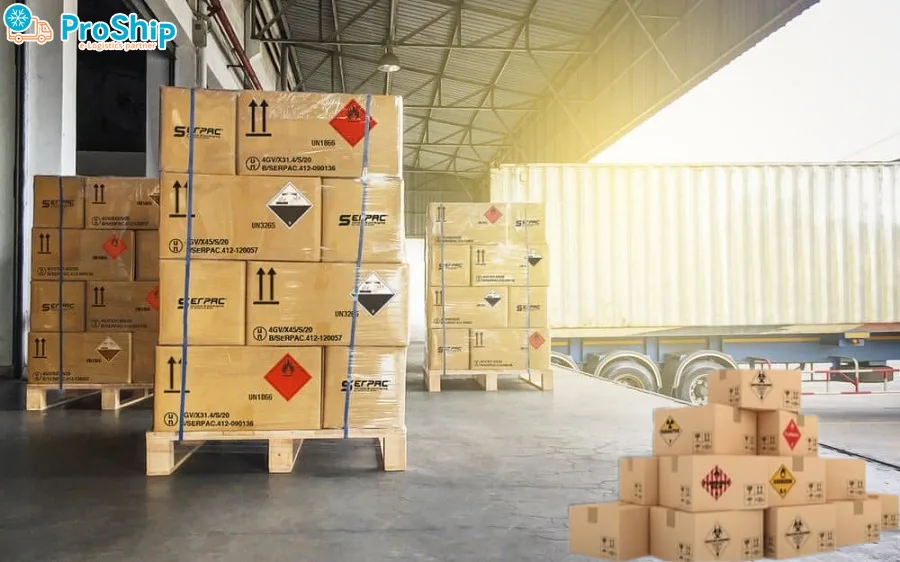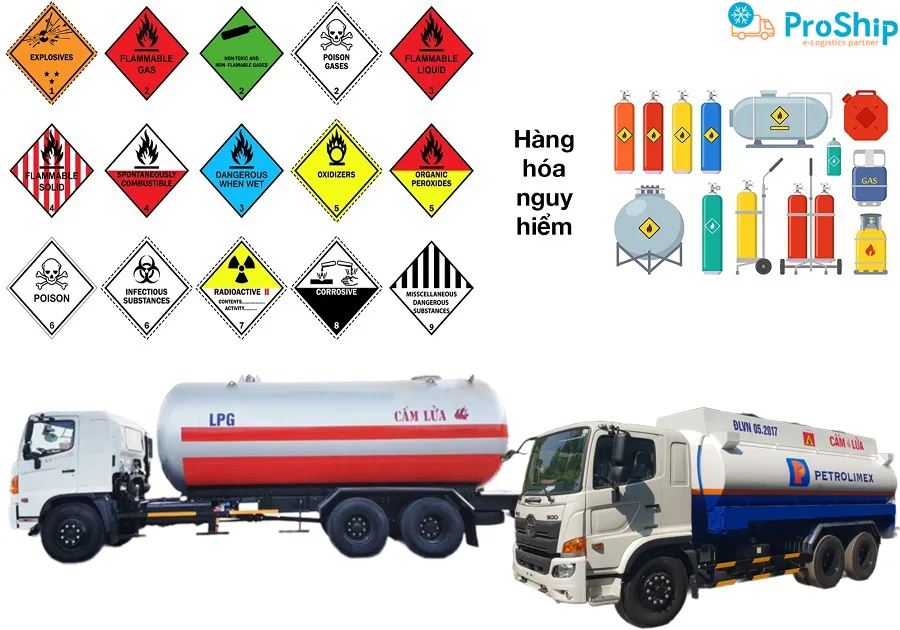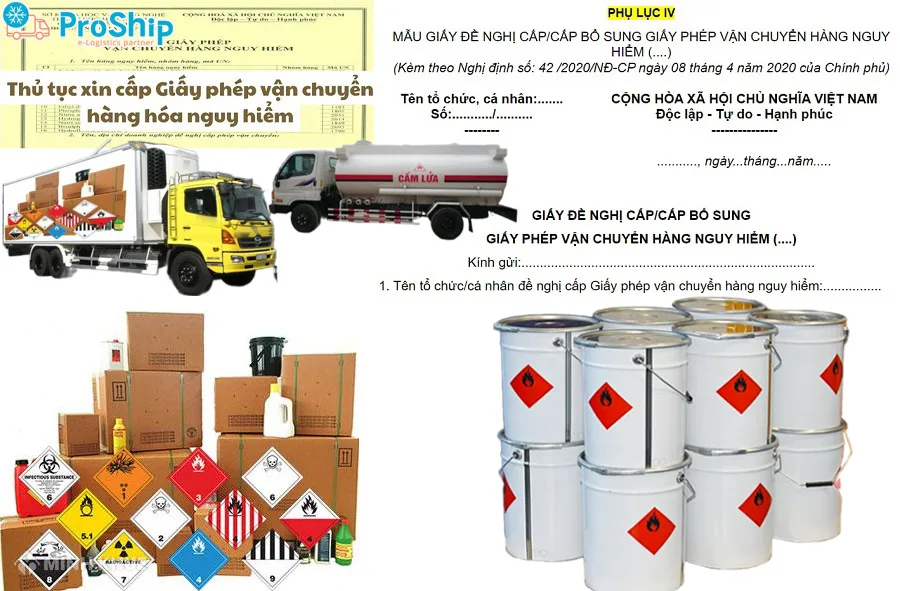x Các cá nhân, tổ chức, đơn vị vận chuyển,…cần biết một vài lưu ý liên quan tới giấy phép, cách đóng gói, quy định vận chuyển hàng hóa nguy hiểm?
x Bạn chưa biết mặt hàng nguy hiểm của mình thuộc nhóm nào, phân loại ra sao?
x Bạn thắc mắc về các loại giấy phép chuyển hàng nguy hiểm gồm những gì, do cơ quan ban ngành nào cấp phép?
PROSHIP.VN chúng tôi sẽ cập nhật những điều cần biết khi vận chuyển hàng hóa nguy hiểm cho các Tổ chức, Cá nhân tham khảo và áp dụng để quá trình vận chuyển mặt hàng này diễn ra suôn sẻ, thuận lợi.
Thực trạng về vận tải hàng nguy hiểm hiện nay
Những năm gần đây, vận tải hàng nguy hiểm đã có những bước phát triển mạnh mẽ, các Doanh nghiệp vận tải (trong đó có Proship Logistics) từng bước tạo được uy tín cho các đối tác có nhu cầu về vận chuyển hàng hóa nguy hiểm.
Vận tải hàng nguy hiểm là việc tiềm ẩn nhiều rủi ro. Chính vì vậy, việc vận chuyển mặt hàng này luôn nhận được sự quan tâm lớn từ các Cơ quan thẩm quyền và có chức năng.

Việc vận chuyển mặt hàng này cần tuân thủ các Nghị định của Thủ tướng Chính phủ về nhiều mặt, bao gồm: phương tiện, giấy phép, quy định, ký hiệu, cách đóng gói, biện pháp PCCC,…để đảm bảo an toàn cho người vận chuyển, người sở hữu sản phẩm cũng như người dân đi đường.
>>Xem thêm: Nhận hàng nhập khẩu đường biển
Những điều CẦN BIẾT khi chuyển hàng nguy hiểm
Dưới đây là những điều cần biết khi vận chuyển hàng hóa nguy hiểm mà Proship Logistics đã tổng hợp được từ nhiều nguồn đáng tin cậy:
Hàng nguy hiểm là gì?
Hàng nguy hiểm là hàng hóa có chứa các chất nguy hiểm khi vận chuyển có khả năng gây nguy hại tới tính mạng, sức khỏe con người, môi trường, an toàn và an ninh quốc gia.
Phân loại hàng hóa nguy hiểm
Loại 1: Chất nổ và vật phẩm dễ nổ gồm các nhóm sau:
- Nhóm Chất, vật phẩm có nguy cơ nổ rộng;
- Nhóm Chất, vật phẩm có nguy cơ bắn tóe nhưng không nổ rộng;
- Nhóm Chất, vật phẩm có nguy cơ cháy và nguy cơ nổ nhỏ hoặc bắn tóe nhỏ hoặc cả hai, nhưng không nổ rộng;
- Nhóm Chất, vật phẩm có nguy cơ không đáng kể;
- Nhóm Chất rất không nhạy nhưng có nguy cơ nổ rộng;
- Nhóm Vật phẩm đặc biệt không nhạy, không có nguy cơ nổ rộng.
Loại 2: Khí gồm các nhóm sau:
- Nhóm Khí dễ cháy;
- Nhóm Khí không dễ cháy, không độc hại;
- Nhóm Khí độc hại.
Loại 3: Chất lỏng dễ cháy và chất nổ lỏng khử nhạy
Loại 4: Gồm các nhóm sau:
- Nhóm Chất rắn dễ cháy, chất tự phản ứng, chất nổ rắn được ngâm trong chất lỏng hoặc bị khử nhạy;
- Nhóm Chất có khả năng tự bốc cháy;
- Nhóm Chất khi tiếp xúc với nước tạo ra khí dễ cháy.
Loại 5: Gồm các nhóm sau:
- Nhóm Chất ôxi hóa;
- Nhóm Perôxít hữu cơ.
Loại 6: Gồm các nhóm sau:
- Nhóm Chất độc;
- Nhóm Chất gây nhiễm bệnh.
Loại 7: Chất phóng xạ.
Loại 8: Chất ăn mòn.
Loại 9: Chất và vật phẩm nguy hiểm khác.

Tổ chức, cá nhân chuyển hàng nguy hiểm cần làm gì?
Xuất trình Phiếu an toàn hóa chất
Phiếu an toàn hóa chất trong vận chuyển hàng nguy hiểm nội địa có vai trò tương tự như Bảng phân tích thành phần lý hóa MSDS (in Tiếng Việt) gồm các thông tin:
- Phương thức – cách nhận Nhận dạng hóa chất;
- Thông tin, thành phần chi tiết của các chất được vận chuyển;
- Nhận dạng đặc tính – khả năng nguy hiểm của hóa chất;
- Nhận dạng đặc lý – hóa của chất;
- Khả năng hoạt động và mức độ ổn định của hóa chất;
- Thông tin về độc tính có trong chất được vận chuyển;
- Thông tin về sinh thái;
- Biện pháp sơ cứu y tế khi có trường hợp người gặp sự cố khi vận chuyển chất nguy hiểm;
- Biện pháp xử lý hỏa hoạn trong trường hợp xấu;
- Biện pháp phòng ngừa, ứng phó cho người vận chuyển khi có sự cố xảy ra;
- Yêu cầu về bảo quản, cất giữ;
- Khả năng tác động lên người và các thiết bị đáp ứng yêu cầu bảo vệ cá nhân;
- Yêu cầu trong việc thải bỏ;
- Yêu cầu quan trọng trong vận chuyển;
- Quy chuẩn kỹ thuật vận chuyển và quy định pháp luật phải tuân thủ trong quá trình;
- Các thông tin cần thiết – quan trọng khác,…
Cung cấp bảng phân tích thành phần lý hóa
Với Dịch vụ vận chuyển hàng nguy hiểm quốc tế, Bảng phân tích thành phần lý hóa (Material Safety Data Sheet – MSDS) là giấy tờ quan trọng và bắt buộc, giúp xác định chính xác các thành phần, thuộc tính của hóa chất hoặc của loại sản phẩm nguy hiểm đang được vận chuyển.
Quy định của Chính phủ về vận tải hàng nguy hiểm
Theo Nghị định 42/2020/NĐ-CP của Chính phủ ban hành dành cho vận tải các loại hàng nguy hiểm đường bộ và đường thủy, gồm:
- Với đường thủy khi đi trên phà, các phương tiện vận chuyển hàng nguy hiểm (đã được cấp phép) không được ở cùng với hành khách và người tham gia giao thông khác.
- Với đường bộ, các phương tiện cơ giới tham gia giao thông đường bộ khi đi vào đường hầm có chiều dài từ 100m thì không được phép vận chuyển thuốc nổ, khí ga, xăng, dầu và chất dễ cháy nổ khác.
- Phương tiện chuyển hàng nguy hiểm phải dán biểu trưng hàng nguy hiểm (nếu chở cùng lúc nhiều loại hàng khác nhau phải dán đủ biểu trưng của hàng hóa đó). Vị trí yêu cầu là dán phía sau phương tiện vận tải.
Cách đóng gói, đánh dấu và bao bì khi chuyển hàng nguy hiểm
Quy định về cách đóng gói, đánh dấu, dán nhãn được làm rõ trong Thông tư số 52/2013/TT-BTNMT của Bộ Tài nguyên và Môi trường:
- Hóa chất dễ cháy nổ: Đóng gói kín, tránh xa lửa và các tác nhân gây lửa trong quá trình vận chuyển;
- Hóa chất độc hại, lây nhiễm: Người thực hiện đóng gói, vận chuyển cần được trang bị bảo hộ lao động;
- Hóa chất dễ ăn mòn, dễ phản ứng: Đựng bằng lọ thủy tinh hoặc các chất liệu thay thế phù hợp;
- Hàng hóa dễ bắt lửa: Dùng xe thùng kín chuyên dụng để vận chuyển, kê hàng lên kệ, tránh tiếp xúc trực tiếp với thùng xe;
- Xăng, dầu: Sử dụng xe chuyên dụng.
Giấy phép chuyển hàng nguy hiểm gồm những gì, ai cấp phép?
Để vận chuyển hàng hóa nguy hiểm, trước tiên Đơn vị vận tải sẽ phải xin Giấy phép vận chuyển từ các Bộ phụ trách:
- Bộ Công an có quyền cấp Giấy phép vận chuyển cho hàng hóa nguy hiểm nhóm 1, 2, 3, 4, 9;
- Bộ Y tế có quyền cấp Giấy phép để vận chuyển hóa chất độc hại dùng trong y tế, các hóa chất diệt khuẩn, diệt côn trùng trong lĩnh vực gia dụng;
- Bộ Khoa học và Công nghệ có quyền cấp Giấy phép vận chuyển cho hàng nguy hiểm nhóm 5, 7, 8;

- Bộ Nông nghiệp và Phát triển Nông thôn có quyền cấp Giấy phép vận chuyển cho các hóa chất bảo vệ thực vật.
- Bộ Công thương có quyền cấp Giấy phép vận tải cho hàng hóa nguy hiểm nhóm 2, 3 và các chất xăng dầu, khí đốt, các chất độc nguy hiểm;
- Với vận chuyển hàng nguy hiểm phục vụ quân sự, quốc phòng và lợi ích quốc gia, an ninh lực lượng vũ trang được quy định định bởi Bộ trường Bộ Quốc Phòng và Bộ trưởng Bộ Công An.
Trên đây là những điều cần biết khi vận chuyển hàng hóa nguy hiểm cùng các quy định liên quan như quy định về cách đóng gói, cách dán bao bì, cách xin giấy phép chuyển hàng nguy hiểm,…Nếu bạn có thắc mắc gì hoặc có nhu cầu sử dụng Dịch vụ vận chuyển hàng Đa phương thức giá rẻ, liên hệ ngay 0909 344 247.
Có thể bạn quan tâm:

